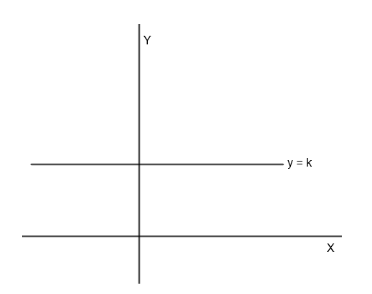
Give examples of two one-one functions \[{{f}_{1}}\] and \[{{f}_{2}}\] from R to R such that \[{{f}_{1}}+{{f}_{2}}:R\to R\] defined by \[\left( {{f}_{1}}+{{f}_{2}} \right)\left( x \right)={{f}_{1}}\left( x \right)+{{f}_{2}}\left( x \right)\] is not one-one.
Answer
606.9k+ views
Hint: For this question make \[{{f}_{1}}\left( x \right)+{{f}_{2}}\left( x \right)=\text{constant}\] as y = k is the easiest function which is not one-one. Take \[{{f}_{1}}\left( x \right)\] and \[{{f}_{2}}\left( x \right)\] as linear function in x such that \[{{f}_{1}}\left( x \right)+{{f}_{2}}\left( x \right)\] is constant.
Here we have to find two one-one functions \[{{f}_{1}}\] and \[{{f}_{2}}\] R to R such that \[\left( {{f}_{1}}+{{f}_{2}} \right)x={{f}_{1}}\left( x \right)+{{f}_{2}}\left( x \right)\] is not one-one.
We know that one-one function is a function that maps distinct elements of its domain to distinct elements of its co-domain that is for a particular value of x, there is a particular value of y and that value of y should not repeat for any other value of x.
Now, we have to make \[{{f}_{1}}\left( x \right)+{{f}_{2}}\left( x \right)\] such that it is not one-one.
We know that \[f\left( x \right)=\text{constant}\] is the easiest function which is not one-one because its value of y keeps getting repeated for all values of x.

Therefore, we will choose \[{{f}_{1}}\left( x \right)\] and \[{{f}_{2}}\left( x \right)\] such that
\[{{f}_{1}}\left( x \right)+{{f}_{2}}\left( x \right)=k\]
Now, we are given that \[{{f}_{1}}\left( x \right)\] and \[{{f}_{2}}\left( x \right)\] must be one-one.
We know that the easiest one-one function is \[y=ax+b:R\to R\] where a and b are constants as it gives different values of y for different values of x.
Therefore, we take \[{{f}_{1}}\left( x \right)=9x+5\].
Now to make \[{{f}_{1}}\left( x \right)+{{f}_{2}}\left( x \right)\] constant, 9x must disappear.
Therefore, we take \[{{f}_{2}}\left( x \right)=-9x+8\].

Therefore, we get \[{{f}_{1}}\left( x \right)+{{f}_{2}}\left( x \right)=\left( 9x+5 \right)+\left( -9x+8 \right)\].
\[\Rightarrow {{f}_{1}}\left( x \right)+{{f}_{2}}\left( x \right)=13\]
Therefore, finally we get
\[{{f}_{1}}\left( x \right)=9x+5\]
\[{{f}_{2}}\left( x \right)=-9x+8\]
which are one-one functions.
Also, we get \[{{f}_{1}}\left( x \right)+{{f}_{2}}\left( x \right)=13\] which is not a one-one function.
Note: Students could also check if a function is one-one or not by making the line on the graph of the function which is parallel to the x axis. If this line cuts the graph just 1 time then, it is one-one function, otherwise it is not one-one.
Here we have to find two one-one functions \[{{f}_{1}}\] and \[{{f}_{2}}\] R to R such that \[\left( {{f}_{1}}+{{f}_{2}} \right)x={{f}_{1}}\left( x \right)+{{f}_{2}}\left( x \right)\] is not one-one.
We know that one-one function is a function that maps distinct elements of its domain to distinct elements of its co-domain that is for a particular value of x, there is a particular value of y and that value of y should not repeat for any other value of x.
Now, we have to make \[{{f}_{1}}\left( x \right)+{{f}_{2}}\left( x \right)\] such that it is not one-one.
We know that \[f\left( x \right)=\text{constant}\] is the easiest function which is not one-one because its value of y keeps getting repeated for all values of x.

Therefore, we will choose \[{{f}_{1}}\left( x \right)\] and \[{{f}_{2}}\left( x \right)\] such that
\[{{f}_{1}}\left( x \right)+{{f}_{2}}\left( x \right)=k\]
Now, we are given that \[{{f}_{1}}\left( x \right)\] and \[{{f}_{2}}\left( x \right)\] must be one-one.
We know that the easiest one-one function is \[y=ax+b:R\to R\] where a and b are constants as it gives different values of y for different values of x.
Therefore, we take \[{{f}_{1}}\left( x \right)=9x+5\].
Now to make \[{{f}_{1}}\left( x \right)+{{f}_{2}}\left( x \right)\] constant, 9x must disappear.
Therefore, we take \[{{f}_{2}}\left( x \right)=-9x+8\].

Therefore, we get \[{{f}_{1}}\left( x \right)+{{f}_{2}}\left( x \right)=\left( 9x+5 \right)+\left( -9x+8 \right)\].
\[\Rightarrow {{f}_{1}}\left( x \right)+{{f}_{2}}\left( x \right)=13\]
Therefore, finally we get
\[{{f}_{1}}\left( x \right)=9x+5\]
\[{{f}_{2}}\left( x \right)=-9x+8\]
which are one-one functions.
Also, we get \[{{f}_{1}}\left( x \right)+{{f}_{2}}\left( x \right)=13\] which is not a one-one function.
Note: Students could also check if a function is one-one or not by making the line on the graph of the function which is parallel to the x axis. If this line cuts the graph just 1 time then, it is one-one function, otherwise it is not one-one.
Recently Updated Pages
Master Class 12 Economics: Engaging Questions & Answers for Success

Master Class 12 Maths: Engaging Questions & Answers for Success

Master Class 12 Biology: Engaging Questions & Answers for Success

Master Class 12 Physics: Engaging Questions & Answers for Success

Master Class 8 Maths: Engaging Questions & Answers for Success

Class 8 Question and Answer - Your Ultimate Solutions Guide

Trending doubts
Which animal has three hearts class 11 biology CBSE

1 Quintal is equal to a 110 kg b 10 kg c 100kg d 1000 class 11 physics CBSE

Explain zero factorial class 11 maths CBSE

Mention the basic forces in nature class 11 physics CBSE

What is centripetal acceleration Derive the expression class 11 physics CBSE

Bond order ofO2 O2+ O2 and O22 is in order A O2 langle class 11 chemistry CBSE




